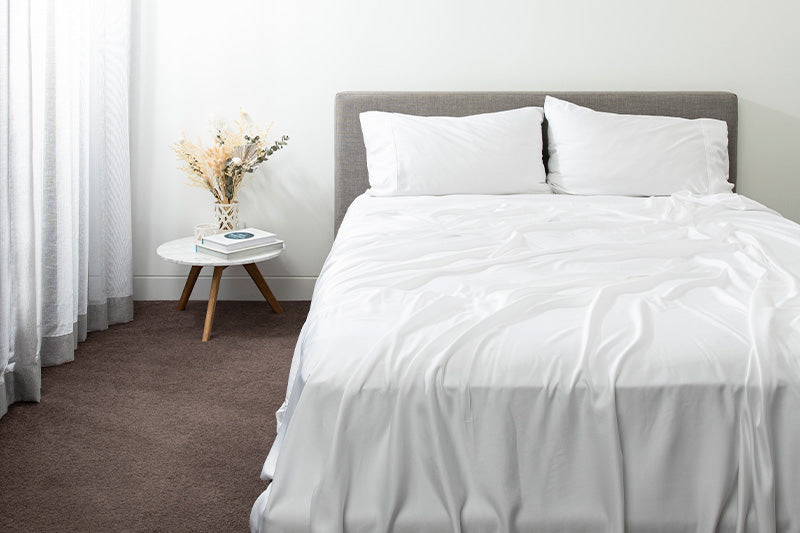Ultimate Guide To How Bamboo Sheets Are Made

Bamboo plants are one of those magical plants that seems to have no end to it's variety of uses.
From flooring and roofing, to clothing, decorative purposes and sustenance for beautiful pandas, there's not many things bamboo can't do.
Here at Ecoy, we offer our customers a unique experience to dream, play and sleep in bamboo sheets. But have you ever wondered how bamboo bed sheets are made?
If you have then this comprehensive guide will teach you everything there is to know about how the bamboo plant is turned into bamboo bedding.
Turning the bamboo plant into bamboo linen

The process of creating bamboo fabrics is one of manufacturing. Bamboo linen is made from bamboo fiber and bamboo fiber comes from specific parts of the bamboo plant.
The main component used to make bamboo fabric is bamboo viscose, which is also known as bamboo rayon. Which term you use will widely depend on which part of the world you're in; rayon for North America and viscose for Europe.
Bamboo rayon is a versatile cellulose fiber known for being incredibly soft, moisture wicking and with the ability to keep you warm in winter and cool in summer, making bamboo sheets perfect for hot sleepers!
But what about lyocell you ask?
The difference between lyocell and rayon/viscose
In the grand scheme of things, not that much.
Both are semi-synthetic fabrics made from cellulose fiber with the all the benefits of bamboo. Lyocell is actually a form of rayon in principle.
Where they differ is in their ability to drape and be absorbent, with lyocell being a touch better at both.
But we digress, back to the main question of "how are bamboo sheets made?".
The process for making bamboo fabric/rayon

Here is a rundown of the manufacturing process according to Bamboo Detective, from a natural bamboo plant right through to completed bamboo sheets.
Plant the bamboo
First and foremost, bamboo needs to grow. The best time of year is usually between March-June but many horticulture experts say September-October also works well.
Time to harvest
Pinpointing the right time to harvest bamboo is relatively simple - once new shoots start to sprout, it's time to harvest!
Chop the bamboo up
Once harvest has been completed, manufacturers chop the bamboo up into strips, usually cut at a 45 degree angle to avoid splitting.
Plant is smashed to create bamboo pulp
Manufacturers then smash the bamboo stalks up and use a machine commonly known as a pulper to heat the raw plant up to roughly 145 Celsius using steam which results in the creation of a liquid known as bamboo pulp.
Pulp is filtered to create bamboo fibers
Using a chemical process, the pulp is mechanically reshaped to extract cellulose. Typically speaking, this process can take between 1-3 hours.
Bamboo fibers are then softened
Using a combination of water and chemicals, typically sodium hydroxide, the cellulose is left to soak in the combination for a period of time, usually at a temperature between 20-25 Celsius.
Material is then spun into yarn
Once the bamboo cellulose has been left to soak it is then processed and spun into yarn.
Bamboo yarn processed into bamboo fabric
The final step in the process - manufacturers use a spinning process to turn the yarn into bamboo fabric. From there, the fabric is used to create incredibly soft, smooth, silky, delightful bamboo sheets.
In Summary

So there you have it, your answer to how bamboo sheets are made!
It's essentially a manufacturing process that involves a series of steps. We should note that the process will vary slightly from one manufacturer to another, but the fundamental steps remain the same.
If you're considering sheets made of bamboo for you or your loved ones, you can sleep risk free for 100 nights with our incredibly soft bamboo bed sheets and if you're not satisfied, simply return them.
We donate any unwanted returns to those in need within our communities, so you don't have to worry about them going to waste.
Sources
- Bamboo Detective, "How is Bamboo Fabric Made", June 25 2019 (Accessed October 2021)
- Owlcation, "Bamboo Fiber: The Manufacturing Process and Fabric Care", April 10 2020 (Accessed October 2021)
